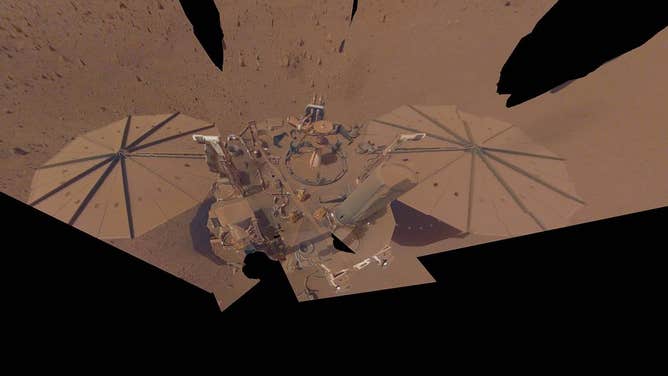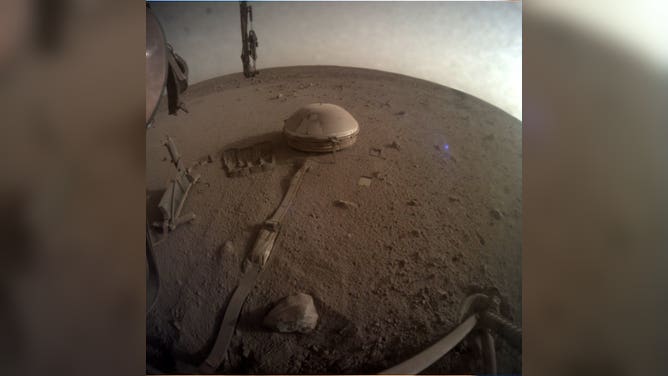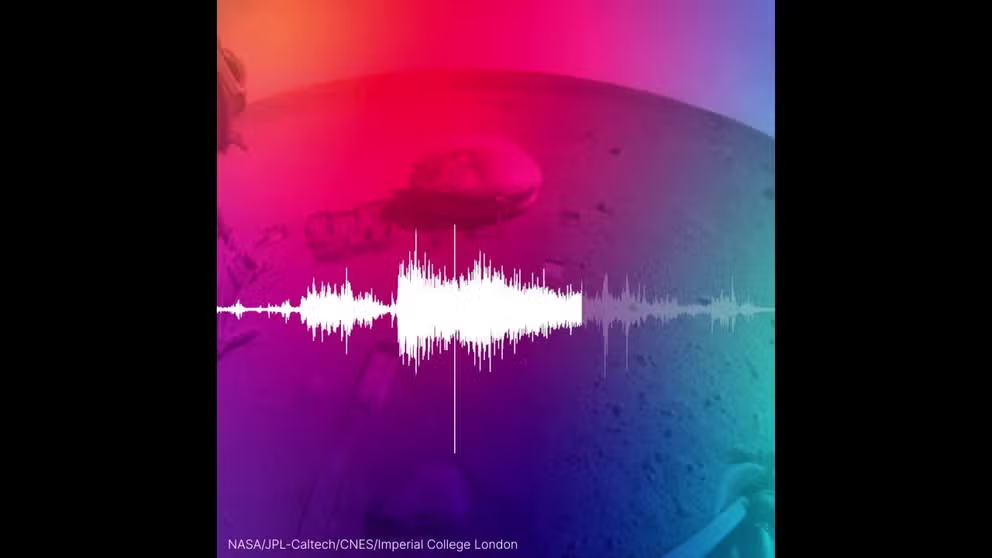NASA says goodbye to Mars Insight lander after 4 years of detecting Marsquakes, listening for dust devils
NASA was waiting on a dust devil to move some Martian dirt off InSight's solar panels, but the space agency said it has likely heard from the 'mole of Mars' for the final time.

NASA's InSight Mars lander took this final selfie on April 24, 2022, the 1,211th Martian day, or sol, of the mission. The lander is covered with far more dust than it was in its first selfie, taken in December 2018, not long after landing. (Image Credit: NASA/JPL-Caltech)
(NASA)
NASA is saying goodbye to the Mars InSight lander as it celebrates the first robotic seismologist on the red planet.
The Interior Exploration using Seismic Investigations, Geodesy and Heat Transport lander, or InSight, had been waiting on a dust devil to blow off Martian dirt from its solar panels, allowing just a glimpse of sunlight to come through. Insight's power has been declining since this summer as more Martian dust build up reduced sunlight, the lander's primary power source.
Mission controllers at NASA's Jet Propulsion Laboratory in California say Insight's solar-powered batteries are "dead bus" or out of power. The last "selfie" taken by InSight in May showed its two 7-foot panels covered in rust-colored powder.
"InSight has more than lived up to its name. As a scientist who’s spent a career studying Mars, it’s been a thrill to see what the lander has achieved, thanks to an entire team of people across the globe who helped make this mission a success," NASA JPL Director Laurie Leshin said. "Yes, it’s sad to say goodbye, but InSight’s legacy will live on, informing and inspiring."
LISTEN TO A MARTIAN DUST DEVIL: THE FIRST RECORDING EVER COULD BE THE KEY TO FUTURE MISSIONS
On Dec. 19, the space agency shared what is likely the last image taken by InSight.

The last photo taken by NASA's Mars InSight Lander sent back around Dec. 15, 2022. (Image: NASA)
(NASA)
"My power’s really low, so this may be the last image I can send. Don’t worry about me, though: my time here has been both productive and serene. If I can keep talking to my mission team, I will – but I’ll be signing off here soon. Thanks for staying with me," NASA's InSight Twitter account wrote.
NASA declared the mission over this week after being unable to communicate with InSight since Dec. 15. However, the agency will continue to listen for the lander's signal, but NASA said it's unlikely it will hear from InSight again.
"We’ve thought of InSight as our friend and colleague on Mars for the past four years, so it’s hard to say goodbye," InSight principal investigator Bruce Banerdt, of JPL, said. "But it has earned its richly deserved retirement."
The robot, sometimes called the "mole of Mars," landed on Nov. 26, 2018, in the Elysium Planitia region to investigate Martian seismic activity and learn about Mars' interior and how it formed.
InSight was designed to bury a sensor 16 feet into the Martian ground. However, the lander couldn't get enough traction into the clumpy soil, and the instrument built by the German Aerospace Center was eventually buried just below the dirt.
Despite the setback, the lander was still able to successfully take the "vital signs" of Mars using the seismometer.
LISTEN: Mars Insight lander records meteor crashing into Red Planet
This video includes a seismogram and sonification of the signals recorded by NASA’s InSight Mars lander, which detected a giant meteoroid strike on Dec. 24, 2021, the 1,094th Martian day, or sol, of the mission. (Credits: NASA/JPL-Caltech/CNES/Imperial College London.)
During its four years on Mars, NASA said InSight's seismometer detected more than 1,300 quakes, including a magnitude 5 quake in May.
The mole also documented the cosmic sounds of Mars.
It recorded its first quake created by a meteoroid striking Mars in September 2021, according to NASA. It was the first time a seismic signal from a space rock impact was detected on another world.
On its 1,094th Martian Day, or sol, in December 2021, InSight recorded a giant meteoroid striking the red planet.
InSight's recordings of dust devils or vortices also helped inform planetary scientists working on other Martian robotic missions, including NASA's Perseverance rover about 2,145 miles away from the lander.
Even as InSight enters "retirement," Banerdt said the seismology data from InSight will be studied for years to come.
